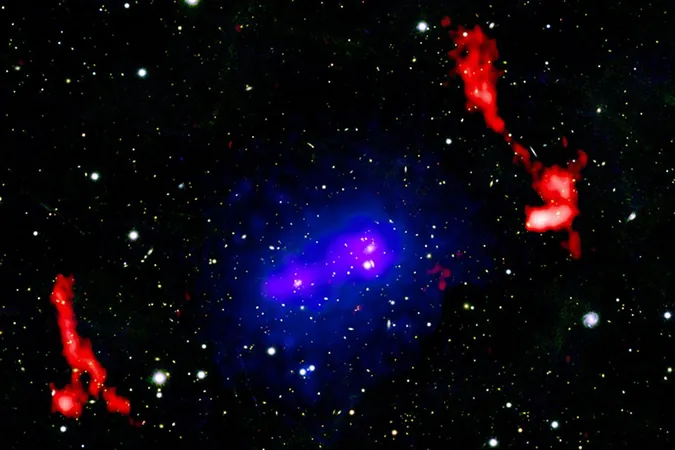
Galactic Showdown: Two Collision-Course Galaxy Clusters Set to Smash Again!
2025-06-06
Author: Yu
A Cosmic Collision of Epic Proportions
Prepare for a spectacle on the cosmic stage! Two colossal galaxy clusters, located a staggering 2.8 billion light-years from Earth, have locked in a fierce collision and are gearing up for a dramatic rematch. Astronomers have front-row seats to this astronomical marvel!
The Battle of the Galaxy Giants
These enormous clusters, known as PSZ2 G181.06+48.47 (or PSZ2 G181), boast hundreds to thousands of galaxies, massive amounts of dark matter, and swirling clouds of superheated gas. Their initial collision was an awe-inspiring event, and new observations suggest they are gravitating towards each other once more.
Observations from the Frontlines
Thanks to advanced telescopes like NASA's Chandra X-ray Observatory and ESA's XMM-Newton, as well as impressive ground-based arrays like LOFAR and Pan-STARRS, scientists have captured breathtaking details of the aftermath of their first encounter—and the hints of an impending second clash!
Shockwaves Across the Universe
A composite image from these observations reveals striking crescent-shaped shock fronts surrounding the clusters. These cosmic disturbances, reminiscent of sonic booms, were likely generated by the high-speed impact of their initial collision about a billion years ago. Spanning 11 million light-years apart, these shock fronts are the largest ever observed in a galaxy cluster collision.
The Cosmic Countdown to Impact
The giants may be separated by vast distances, but their gravitational pull keeps them bound. The latest X-ray insights from Chandra and XMM-Newton have unveiled three distinct shock fronts that align perfectly with the clusters' direction of movement. This harmony indicates that after slowing down, the two are beginning to converge once again.
A Unique Scientific Opportunity
Lead author Andra Stroe, from the Center for Astrophysics | Harvard & Smithsonian, highlights the significance of this impending collision. This second encounter presents a golden opportunity for scientists to study how smaller, lower-mass systems like PSZ2 G181 respond to the cataclysmic forces typically seen in larger galaxy clusters.
Unlocking the Mysteries of the Universe
Galactic collisions are among the most energetic phenomena in the universe. They not only reshape cosmic structures but also offer crucial insights into the elusive dark matter and the dynamics of galaxy evolution. As researchers gear up to witness this cosmic showdown, the potential for groundbreaking discoveries is simply astronomical!

 Brasil (PT)
Brasil (PT)
 Canada (EN)
Canada (EN)
 Chile (ES)
Chile (ES)
 Česko (CS)
Česko (CS)
 대한민국 (KO)
대한민국 (KO)
 España (ES)
España (ES)
 France (FR)
France (FR)
 Hong Kong (EN)
Hong Kong (EN)
 Italia (IT)
Italia (IT)
 日本 (JA)
日本 (JA)
 Magyarország (HU)
Magyarország (HU)
 Norge (NO)
Norge (NO)
 Polska (PL)
Polska (PL)
 Schweiz (DE)
Schweiz (DE)
 Singapore (EN)
Singapore (EN)
 Sverige (SV)
Sverige (SV)
 Suomi (FI)
Suomi (FI)
 Türkiye (TR)
Türkiye (TR)
 الإمارات العربية المتحدة (AR)
الإمارات العربية المتحدة (AR)